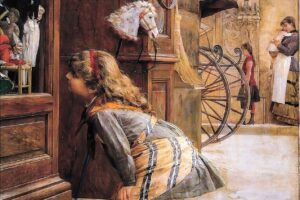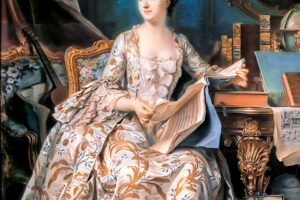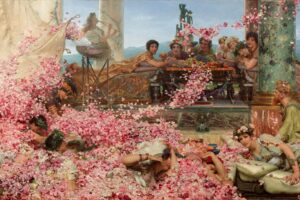Overview
The Accolade (1901) by Edmund Blair Leighton is one of the most iconic images of chivalry in art. It depicts a medieval queen or lady conferring knighthood upon a kneeling warrior. Clad in gleaming armor and draped in a red surcoat, the knight bows his head as the lady, robed in flowing white and gold, gently touches his shoulder with a sword.
Blair Leighton, known for his romanticized visions of the Middle Ages, crafted this painting as both spectacle and allegory. Though created at the dawn of the 20th century, it reflects Victorian ideals of honor, loyalty, and beauty, making it a timeless celebration of courtly ritual.
The Story Behind the Painting
Edmund Blair Leighton’s Historical Romanticism
Blair Leighton (1852–1922) specialized in medieval and Regency scenes, often staged with exquisite attention to costume and architecture. While not a member of the Pre-Raphaelite Brotherhood, he carried forward their love of narrative, symbolism, and jewel-like detail.
The Medieval Ideal in Victorian Britain
Victorian and Edwardian audiences were captivated by tales of knights, queens, and noble quests. The Accolade offered them a vision of an age defined by ritual, loyalty, and ideals of service. At a time when modernity was reshaping society, such works reflected nostalgia for order and beauty.
Exhibition and Reception
Painted in 1901, The Accolade quickly became one of Blair Leighton’s most celebrated works. It was widely reproduced in prints, postcards, and later as popular posters, ensuring its enduring fame as a symbol of chivalry.
Composition and Subjects
The Kneeling Knight
In the foreground, the knight kneels upon a cushion, head bowed, armored hands resting on his sword. His red surcoat, emblazoned with heraldic black, contrasts sharply with the metallic gleam of his chain mail. He embodies loyalty, humility, and readiness for service.
The Lady Conferring Honor
Above him stands the lady, dressed in a gown of flowing white embroidered with gold. A crown rests on her golden hair, her expression serene yet commanding. With a poised gesture, she lowers her sword upon his shoulder — a moment of transformation from warrior to knight.
Witnesses and Setting
Behind them, courtiers watch the ceremony in solemn stillness, their richly colored garments adding to the spectacle. The stone hall, with its Gothic arches and stained glass, evokes a medieval court at its most ceremonial.
Symbolism of Gesture and Color
The verticality of the lady contrasts with the humility of the kneeling knight, underscoring the dynamics of power, service, and devotion. The white of her gown symbolizes purity, while the red of the knight’s surcoat signifies courage and sacrifice.
Art Style and Techniques
Pre-Raphaelite Legacy
Though painted decades after the Brotherhood’s peak, Blair Leighton employs Pre-Raphaelite principles: luminous colors, precise detail, and narrative symbolism. The folds of fabric, textures of armor, and decorative backdrop are rendered with jewel-like clarity.
Theatrical Staging
The composition is carefully staged like a tableau. Figures, costumes, and setting combine to heighten the sense of ceremony. The effect is almost cinematic — a single frame capturing the grandeur of medieval ritual.
Romantic Idealism
The work prioritizes beauty and harmony over historical accuracy. For Blair Leighton, the Middle Ages were less about gritty realism and more about ideals — loyalty, honor, and service elevated into art.
Legacy and Reflection
A Symbol of Chivalry
The Accolade remains Blair Leighton’s most recognized work. Its imagery has become synonymous with knighthood, reproduced countless times in popular culture, from school posters to fantasy art.
Enduring Appeal
The painting resonates because it distills universal ideals into a single image: the humility of service, the grace of honor bestowed, the timeless attraction of beauty and loyalty. In its harmony of color, gesture, and symbolism, it continues to inspire visions of nobility.
A knight kneels, a lady bestows honor, and for a moment, ritual becomes poetry. In The Accolade, Edmund Blair Leighton transforms medieval ceremony into timeless art — a vision of loyalty, grace, and devotion that still stirs the imagination.
This Painting Featured in (Pre-Raphaelite 1 Spot the Difference Puzzles: Interactive, Printable Flipbook) by Classic Art Puzzles.



